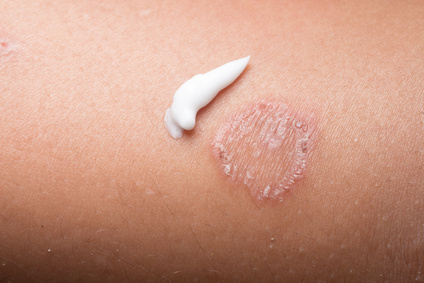Ringworm Treatment
Visit this
PICTURES OF RASHES PAGE
Before pursuing a ringworm treatment, a proper diagnosis needs to take place.
Ringworm Diagnosis
Self diagnosis can be performed by observing the various ring worm symptoms. However, this is simply the first step in a proper diagnosis. To verify that ringworm is actually the skin problem present, a physician needs to be consulted. The physician will take into account your observations, his observations, and may perform some clinical tests to determine if the problem exists and to provide the proper treatment for the ringworm.
Not all red or flaky and itchy patches of skin are the ringworm skin problem. Often several other skin conditions such as psoriasis, eczema, or dermatitis can be mistaken as a ringworm issue. A ringworm treatment will not help these other skin care problems and therefore, the proper ringworm diagnosis is imperative for a proper cure to be implemented.

A
physician will start his or her diagnosis by doing a simple visual analysis of
the skin problem, looking for the classic symptoms for the type of ringworm
that may be present. The physician will also ask some key questions to see if
exposure to a fungal source has recently occurred. Ringworm of the scalp
generally appears anywhere from 10 to 14 days after exposure to an infected
source and body ring worm usually four to ten days.
Some of the ringworm fungi are fluorescent or in other words they give off light when a certain type of light (ultra violet light) illuminates the affected skin area. If fluorescence occurs, then the fungus is present and the skin condition is most likely ring worm.
A more certain diagnosis before suggesting a ring worm treatment is performed via skin scrapings. Areas of affected skin are scraped or sampled and examined under a microscope for the presence of fungi. This test is not always definitive and usually further laboratory testing may be required which likely will include culture tests. Culture tests involve growing the fungi from the skin scrapings under controlled laboratory conditions.
In depth clinical tests are not always performed initially but are more likely performed if the problem is not clearing up after an initial ringworm treatment.
Ringworm Treatment
A ringworm treatment is required when individuals are suffering from ring worm. Without a proper treatment the ringworm rash will not heal, can spread to other areas of the body or to other people, or other problems may arise such as bacterial infections or dermatitis. The treatment can differ depending on the type of ringworm that is present, for example, if it is on the body, foot, scalp, or nails.
Non-Prescription Anti-Fungal Topical Lotion, Cream, or Powder
The usual treatment for ring worm is the use of non-prescription anti-fungal topical medication. This may be in the form of a lotion, cream, or powder. Examples of such products include Lotrimin, Canestan, Mycelex, Desenex, Tinactin, and Micatin. Usually, such products are used for about two weeks. Each medication is different and so ensure instructions are followed properly in order to achieve maximum effectiveness and safety. The topical ringworm creams are not always effective and if an improvement in the ringworm condition does not occur then a visit or return visit to a physician is in order.
Prescription Creams and Oral Medication Treatments
If the skin problem does not improve with non-prescription products, or the skin condition keeps returning, or large areas of the body are affected, then prescription creams might be used. Examples of these creams and lotions include Spectazole and Moni-stat Derm. If prescription creams and lotions are not effective then the doctor may prescribe oral medications. Oral medications tend to be prescribed more often for ringworm of the scalp, face, and nails. Examples of prescription oral medications include Sporanox, Diflucan, Lamisil, Grisactin, and Nizoral. Like many other oral medications for other health ailments, there are possible side effects with some of these medications. The more common side effects include stomach upset and skin rash. In some cases, abnormal liver functioning is a concern. The physician or pharmacist should provide information on the side effects. Treatment routines can take several weeks.
Anti-Fungal Shampoos, Steroids, Natural Ringworm Treatment
Anti-fungal shampoos usually do not cure ringworm of the scalp but can aid in preventing the spread of the skin condition.
To help control the itching and inflammation caused by ringworm, the doctor may prescribe a corticosteroid.
Finally, there is an all natural home ringworm treatment that is available. This is for those where other treatments are not working, those that prefer a natural approach to healing, or for those that do not want to be on medication for long periods of time.
skin care | diagnose my skin rash | ringworm | what is ringworm | ring worm causes | what does ringworm look like | ringworm treatment
